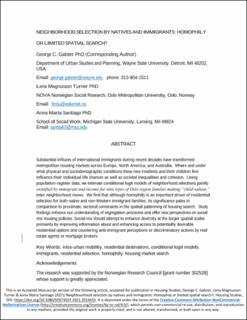| dc.contributor.author | Galster, George | |
| dc.contributor.author | Magnusson Turner, Lena | |
| dc.contributor.author | Santiago, Anna Maria | |
| dc.coverage.spatial | Norway | en_US |
| dc.date.accessioned | 2022-12-01T10:37:47Z | |
| dc.date.available | 2022-12-01T10:37:47Z | |
| dc.date.created | 2022-01-10T16:36:31Z | |
| dc.date.issued | 2021-12-14 | |
| dc.identifier.citation | Housing Studies. 2021, . | en_US |
| dc.identifier.issn | 0267-3037 | |
| dc.identifier.issn | 1466-1810 | |
| dc.identifier.uri | https://hdl.handle.net/11250/3035284 | |
| dc.description.abstract | Substantial influxes of international immigrants during recent decades have transformed metropolitan housing markets across Europe, North America, and Australia. Where and under what physical and sociodemographic conditions these new residents and their children live influence their individual life chances as well as societal inequalities and cohesion. Using population register data, we estimate conditional logit models of neighborhood selections jointly stratified by immigrant and income for nine types of Oslo region families making “child-salient,” inter-neighborhood moves. We find that although homophily is an important driver of residential selection for both native and non-Western immigrant families, its significance pales in comparison to proximate, sectoral constraints in the spatial patterning of housing search. Study findings enhance our understanding of segregation processes and offer new perspectives on social mix housing policies. Social mix should attempt to enhance diversity at the larger spatial scales primarily by improving information about and enhancing access to potentially desirable residential options and countering anti-immigrant perceptions or discriminatory actions by real estate agents or mortgage brokers. | en_US |
| dc.description.sponsorship | The research was supported by the Norwegian Research Council [grant number 302528]. | en_US |
| dc.language.iso | eng | en_US |
| dc.publisher | Routledge | en_US |
| dc.relation.ispartofseries | Housing Studies; | |
| dc.rights | Attribution-NonCommercial-NoDerivatives 4.0 Internasjonal | * |
| dc.rights.uri | http://creativecommons.org/licenses/by-nc-nd/4.0/deed.no | * |
| dc.subject | Intra-urban mobility | en_US |
| dc.subject | Residential destinations | en_US |
| dc.subject | Conditional logit models | en_US |
| dc.subject | Immigrants | en_US |
| dc.subject | Residential selection | en_US |
| dc.subject | Homophily | en_US |
| dc.subject | Housing market search | en_US |
| dc.title | Neighbourhood selection by natives and immigrants: Homophily or limited spatial search? | en_US |
| dc.type | Peer reviewed | en_US |
| dc.type | Journal article | en_US |
| dc.description.version | acceptedVersion | en_US |
| cristin.ispublished | true | |
| cristin.fulltext | postprint | |
| cristin.fulltext | postprint | |
| cristin.qualitycode | 1 | |
| dc.identifier.doi | https://doi.org/10.1080/02673037.2021.2014415 | |
| dc.identifier.cristin | 1977808 | |
| dc.source.journal | Housing Studies | en_US |
| dc.source.pagenumber | 42 | en_US |
| dc.relation.project | Norges forskningsråd: 302528 | en_US |

